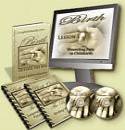The Benefits of Natural Childbirth Relaxation Techniques
Learning natural childbirth relaxation techniques provides many benefits - both mental and physical. In truth, relaxation techniques are critical coping skills for navigating the stresses of everyday life. In today's world, our stress levels are so much higher than ever before. It's not that our lives are harder, but that the types of stress we endure are different.
Much of our stress comes from things that are beyond our control - rising inflation, lessened job security, higher health care costs, unstable economies, tighter budgets... if you weren't stressed before, you are now! When a growing lack of family/community support is factored in, many people are at the end of their rope.
This mental and physical stress can manifest physically. The levels of hormones like adrenaline and cortisol rise, as does blood pressure. Stress can even impair brain function, leading to problems with healing, immune system function, sleep quality, and memory.
In short, without employing relaxation techniques, we are at the mercy of the stress in our lives.
While this is a nightmare for any person, it can be especially dangerous to a pregnancy. With higher blood pressure comes the danger of developing eclampsia. With decreased immunity and healing powers, the body is less equipped to handle and rebound from childbirth. It's also critical to note that when stress manifests physically, the hormonal changes that take place in the body can then affect the pregnancy and developing baby. This can be witnessed in fetal heart rate and growth patterns.
However, many studies have shown that frequent use of relaxation techniques can:
- Boost the immune system.
- Increase a repertoire of coping skills.
- Reduce the incidence of stroke/heart attacks, especially from recurrent ones.
- Improve short-term memory.
- Enhance sleep quality.
When natural childbirth relaxation techniques are implemented, stress and anxiety levels are lowered which can lead to other benefits such as:
- Preventing or lowering the risk of developing eclampsia.
- Lessening complications in pregnancy.
- Shortening overall labor time.
- Leading to more comfortable birthings.
- Reducing postpartum recovery time.
- Improving overall satisfaction and comfort level during pregnancy.
While none of the natural childbirth relaxation techniques will work equally well for every person, there are many options available. Finding what works best for you is the key, and it's enjoyable too.
Return to Top of Natural Childbirth Relaxation
References
Smith CA, Collins CT, Cyna AM, Crowther CA. Complementary and alternative therapies for pain management in labour. Cochrane Database of Systematic Reviews 2006, Issue 4. Art. No.: CD003521. DOI: 10.1002/14651858.CD003521.pub2.Cluett E R, Nikodem VC, McCandlish RE, Burns EE. Immersion in water in pregnancy, labour and birth. Cochrane Database of Systematic Reviews 2002, Issue 2. Art. No.: CD000111. DOI: 10.1002/14651858.CD000111.pub2.
Lowe NK. The nature of labor pain. Am J Obstet Gynecol 2002;186(Suppl 5):S16-24.
Lowe NK. Differences in first and second stage labor pain between nulliparous and multiparous women. J Psychosom Obstet Gynecol 1992;13:243-53.
Sheiner E, Sheiner EK, Shoham-Vardi I. The relationship between parity and labor pain. Int J Gynaecol Obstet 1998;63:287-8.
Ranta P, Jouppila P, Jouppila R. The intensity of labor pain in grand multiparas. Acta Obstet Gynecol Scand 1996;75:250-4.
Slade P, MacPherson SA, Hume A, Maresh M. Expectations, experiences and satisfaction with labour. Br J Clin Psychol 1993;32:469-83.
Waldenstram U. Experience of labor and birth in 1111 women. J Psychosom Res 1999;47:471-82.
Lowe NK. Explaining the pain of active labor: the importance of maternal confidence. Res Nurs Health 1989;12:237-45.
Wuitchik M, Hesson K, Bakal DA. Perinatal predictors of pain and distress during labor. Birth 1990;17:186-91.
Bonnel AM, Boureau F. Labor pain assessment: validity of a behavioral index. Pain 1985;22:81-90.
Ross A. Maternal satisfaction with labour analgesia. Baillieres Clin Obstet Gynaecol 1998;12:499-512.
Hodnett ED. Pain and women's satisfaction with the experience of childbirth: a systematic review. Am J Obstet Gynecol 2002:186(Suppl 5):S160-72.
Simkin PP, O'Hara M. Nonpharmacologic relief of pain during labor: systematic reviews of five methods. Am J Obstet Gynecol 2002;186(Suppl 5): S131-59.
Scott KD, Berkowitz G, Klaus M. A comparison of intermittent and continuous support during labor: a meta-analysis. Am J Obstet Gynecol 1999;180: 1054-9.
Hodnett ED, Lowe NK, Hannah ME, Willan AR, Stevens B, Weston JA, et al. Effectiveness of nurses as providers of birth labor support in North American hospitals: a randomized controlled trial. JAMA 2002;288:1373-81.
Declercq ER, Sakala C, Corry MP. Listening to mothers: report of the First National U.S. Survey of Women's Childbearing Experiences. New York: Maternity Center Association/Harris Interactive Inc., 2002.
Return from Natural Childbirth Relaxation to Women Giving Birth
Return to Giving Birth Naturally Home
Page Last Modified by Catherine Beier, MS, CBE
Most Popular
How to Use Acupressure to Induce Labor
Childbirth Relaxation Script MP3s
Nutrition During Pregnancy - Nix the Notion of Eating for Two
Looking for a Birth Professional? Search our Provider Directory
Online Childbirth Classes
Choose 7 week, 12 week, or Self- Paced online childbirth classes available wherever and whenever you need them.
Featured Birth Story
Vanessa's natural birth story shows that when birth is left alone to proceed as it should, it waits for no one - not even doctors or midwives.
Free Pregnancy Tickers
Create a free pregnancy ticker to post on your blog, website, Facebook profile or favorite social media...




